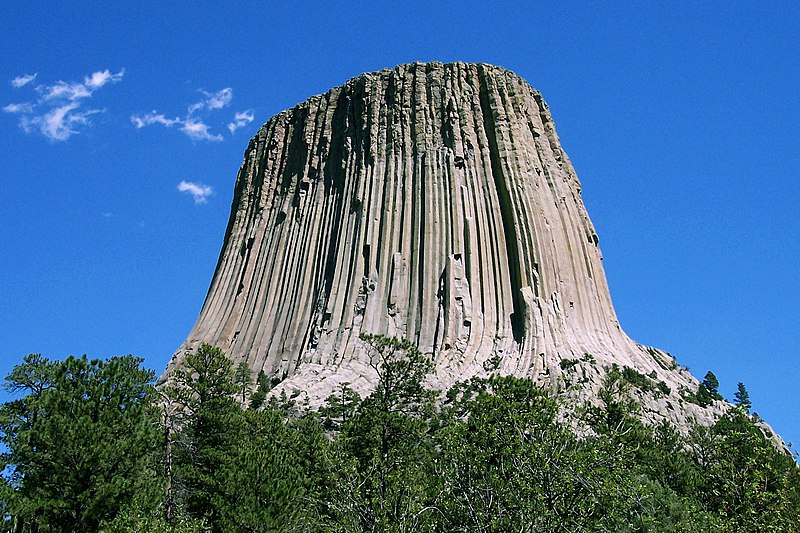And for background....
Surely Wisconsin has experienced Native American politics?
Devils Tower National Monument is a spectacular rock formation of
national and cultural significance. The nearly vertical monolith rises
1,267 feet above the winding Belle Fourche River below and was
proclaimed as America’s first national monument by President Theodore
Roosevelt under the Federal Antiquities Act of 1906. This stunning
feature provides a sanctuary for wildlife, park visitors, rock climbing
enthusiasts, and American Indians.
In fact, over twenty American Indian tribes have a cultural affiliation
with this location. Visitors from many of these tribes use this area
as a part of their religious traditions. The quiet nature of this
unique place lends itself to these customs. However, noise pollution
from low-flying aircraft can disrupt these rituals. In an attempt to
respect this site of religious significance, when the airport at
Hulett, Wyoming (W43) was established, an agreement between the Federal
Aviation Administration, Town of Hulett, Hulett Airport Advisory Board,
and Devils Tower National Monument created a “No Fly Advisory Zone”.
The no-fly advisory zone is centered on Devils Tower, extends for two
nautical miles (2 NM) during the months of July-May, three nautical
miles (3 NM) for the month of June, and includes no overflights
throughout the year. The no-fly advisory zone augments existing
Federal Aviation Administration regulations that encompass National
Park areas.
FAA Rules and Regulations
The main Federal Aviation Administration (FAA) rule (or regulation)
that is applicable to the Devils Tower National Monument is contained
in the FAA’s Advisory Circular 91-36D, which states, “This Advisory
Circular (AC) encourages pilots making VFR flights near noise-sensitive
areas to fly at altitudes higher than the minimum permitted by
regulation and on flight paths that will reduce aircraft noise in such
areas” [1]. The advisory circular goes on to state:
Excessive aircraft noise can result in annoyance,
inconvenience, or interference with the uses and enjoyment of
property, and can adversely affect wildlife. It is
particularly undesirable in areas where it interferes with
normal activities associated with the area’s use, including
residential, educational, health, and religious structures
and sites, and parks, recreational areas (including areas
with wilderness characteristics), wildlife refuges, and
cultural and historical sites where a quiet setting is a
generally recognized feature or attribute. Moreover, the FAA
recognizes that there are locations in National Parks and
other federally managed areas that have unique noise sensitive
values.
Advisory Circular 91-36D notes voluntary actions that pilots should
take to address the concerns noted above. These voluntary practices
include:
a. Avoidance of noise-sensitive areas, if practical, is
preferable to overflight at relatively low altitudes.
b. Pilots operating noise producing aircraft (fixedwing,
rotary-wing and hot air balloons) over noisesensitive
areas should make every effort to fly not less
than 2,000 feet above ground level (AGL), weather
permitting. For the purpose of this AC, the ground level
of noise-sensitive areas is defined to include the highest
terrain within 2,000 feet AGL laterally of the route of
flight, or the uppermost rim of a canyon or valley. The
intent of the 2,000 feet AGL recommendation is to reduce
potential interference with wildlife and complaints of
noise disturbances caused by low flying aircraft over
noise-sensitive areas.
c. Departure from or arrival to an airport, climb after
take-off, and descent for landing should be made so as to
avoid prolonged flight at low altitudes near noisesensitive
areas.
d. This advisory does not apply where it would conflict
with Federal Aviation Regulations, air traffic control
clearances or instructions, or where an altitude of less
than 2,000 feet AGL is considered necessary by a pilot to
operate safely.
The Circular concludes by noting that, “Aircraft operators, aviation
associations, airport managers, and others are asked to assist in
voluntary compliance with this AC by publicizing it and distributing
information regarding known noise-sensitive areas."
Pilots can easily recognize “noise sensitive” areas as defined by the
Circular, because they are presented graphically on the Sectional
Aeronautical Charts that are published by the U.S. Department of
Transportation, Federal Aviation Administration (Figure 2).
The Devils Tower National Monument is currently shown as a noisesensitive
area. However, when it was decided to construct an airport
in Hulett, Wyoming, only 7.5 miles from Devils Tower, it was decided
that additional measures may be necessary to ensure that aircraft do
not disturb the peaceful environment at the Monument.
No-Fly Advisory Zone Notices
Pilots may be unaware of the voluntary no-fly advisory zone around
Devils Tower, unless they are flying into the Hulett, Wyoming airport
(known as W43). Prior to this project, the no-fly advisory zone is
only indicated as a Notice To Airman (NOTAM) for the airport.
Therefore, a pilot flying through the area (a transient pilot) may not
receive, or have access to the advisory information.
In order for the no-fly advisory zone to be widely recognized, it
needed to be documented (or noted) on the appropriate Sectional Charts.
This is due to the fact that most pilots, especially those flying under
Visual Flight Rules (VFR), carry the appropriate charts (Sectional
Charts) with them. However, the graphics and symbols on Sectional
Charts are highly standardized, and it would likely be very difficult
to convince the FAA to create a new symbol/graphic to depict the no-fly
zone around Devils Tower.
After discussions between the Federal Aviation Administration (FAA) and
Devils Tower National Monument, it was agreed that a note should be
added on the Billings Sectional that would advise pilots of the no-fly
advisory zone. The Billings Sectional Chart covers the Devils Tower
National Monument area.
The above essay confuses regulations with advisory circulars, obviously, but you get the drift.





 Sure, I can **** off some indians and tourists, but affect national welfare? I say again, you've gotta be kidding me.
Sure, I can **** off some indians and tourists, but affect national welfare? I say again, you've gotta be kidding me.

